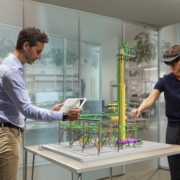Kim Custeau of AVEVA Shares How We Can Build a Better Future Post Covid-19
The Global Asset Performance Management Lead of AVEVA explains why planning and predictive maintenance sets the best foundation
Coronavirus (‘COVID-19’) continues to have a significant impact on all market sectors including the engineering, manufacturing and construction industry. According to Deloitte’s white paper on COVID-19’s impact on the engineering & construction sector, in the long-term, “construction companies across the board will have to contend with decreased demand as governments face rising deficits and residential and commercial projects are dampened by unemployment and low GDP growth.” 1
So, it comes as no surprise that many businesses are looking even closer at improving reliability, performance, safety and controlling costs while maximising value from investments already made.

Setting the Right Foundation with Project Planning
In all capital asset industries, there is a premium on safety, speed and quality of delivery, but construction projects are also characterised by very demanding schedules, global distribution of work, multiple contracts and a drive for seamless start-up and production. Often, this is enforced by strict contractual requirements, but it can also be determined by regional conditions. Late completion of one project can have a detrimental effect on reputations and future business. Together, these factors demand skilful planning and scheduling, and business agility. Complex projects require efficient planning tools to handle the information involved and to present it in ways that enable effective business management.
Any effective planning solution must provide all of the following key features:
- Multiple levels of planning, from enterprise planning to work pack-based engineering deliverables and construction sequence planning
- The ability for several planners simultaneously to develop and optimise schedules for individual aspects of the project
- The ability to analyse and reuse plans from previous projects. Apart from saving time and effort, this can enable more competitive tendering and reduce project risk
- Close integration with the construction management and materials systems to close the feedback loop, providing visibility of progress against plan and enabling timely and effective rescheduling where necessary.
Gaining a Competitive Advantage with Predictive Tools
Predictive Asset Analytics is a modern tool to help organisations gain the highest return on critical assets by supporting predictive maintenance programs with early warning detection of equipment issues ahead of existing operational alarms. Predictive Asset Analytics gives users the ability to quickly transform raw data into actionable insights to prevent equipment failure and make smart decisions that improve operations
Equipment agnostic, Predictive Asset Analytics can also be configured to monitor assets regardless of equipment type, vendor, or asset age without the need for manufacturer specific asset information. While existing machinery sensor data can be input into the software’s advanced modeling process and compared to real-time operating data to determine and alert upon subtle deviations from expected equipment behavior. This is advantageous for organizations because, once an issue has been identified, the software can assist in root cause analysis and provide fault diagnostics to help the user understand the reason and significance of the problem.
Staying at the Top of the Game
Demand for Asset Performance Management (‘APM’) software has increased significantly over the last five years in particular. Verdantix analysis found that global spending across all industries on APM software, content and related services reached US$2.3 billion in 2019.2
Technological advancements mean that Predictive Asset Analytics can now integrate with a wide variety of data historian solutions, control and monitoring systems and can be deployed on-premise or in the cloud. This effectively means that organisations can monitor a single asset, a specific plant or hundreds of remote assets across multiple sites from a single point. Unscheduled downtime can be reduced through personnel receiving early warning notifications of developing issues.
Instead of shutting down equipment immediately, the situation can be assessed for more convenient outcomes. Maintenance costs can also be reduced through better planning; parts can be ordered and shipped without rush and equipment can continue running. Other benefits include increased asset utilization and life, as well as identifying underperforming assets.
When the world and construction projects return to normality, inevitably there will be questions about schedule delays and there will also be a scramble for labour, materials and equipment. Organisations can stay ahead of the curve by taking affirmative action now in order to keep existing projects and processes on track.
References:
1. Deloitte: COVID-19’s impact on the engineering & construction sector
2. Verdantix 2020 Green Quadrant for Asset Performance Management (APM) Solutions Report here.

